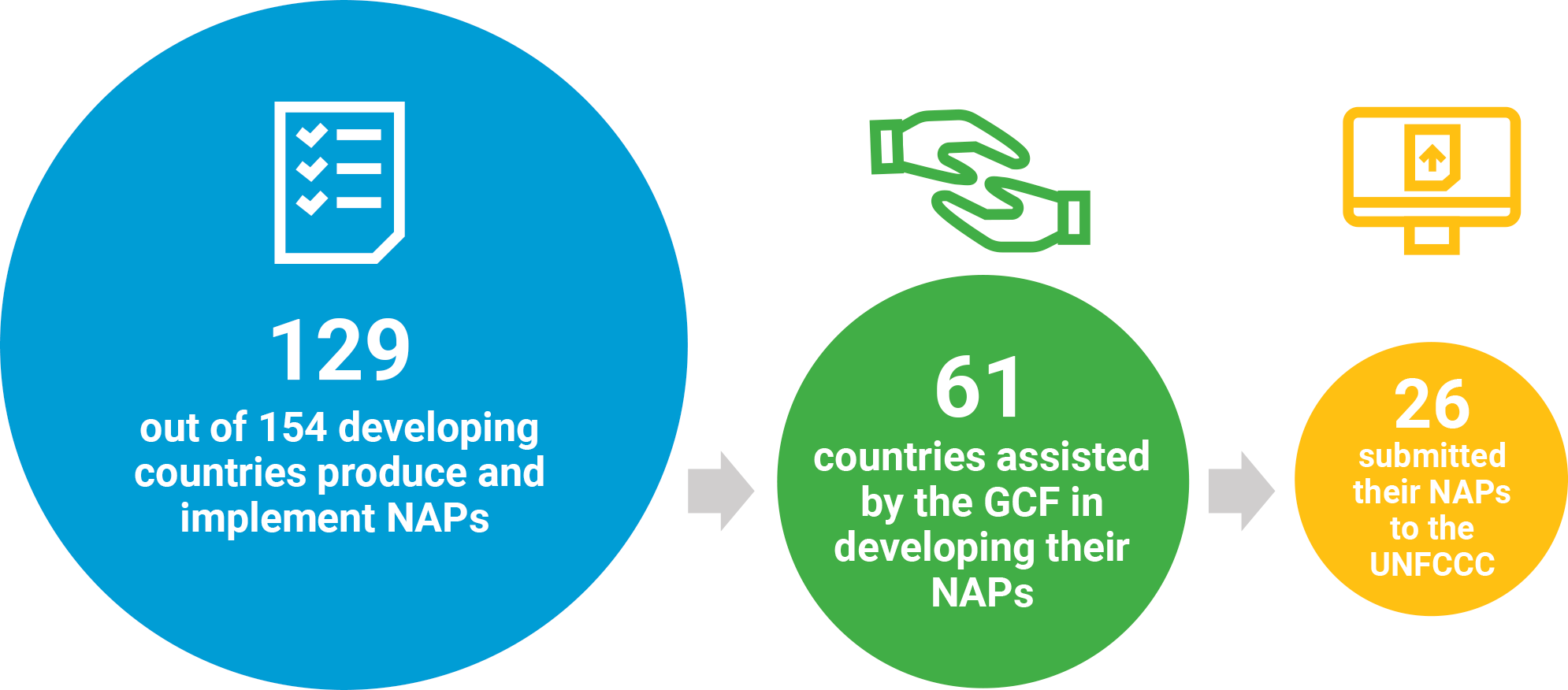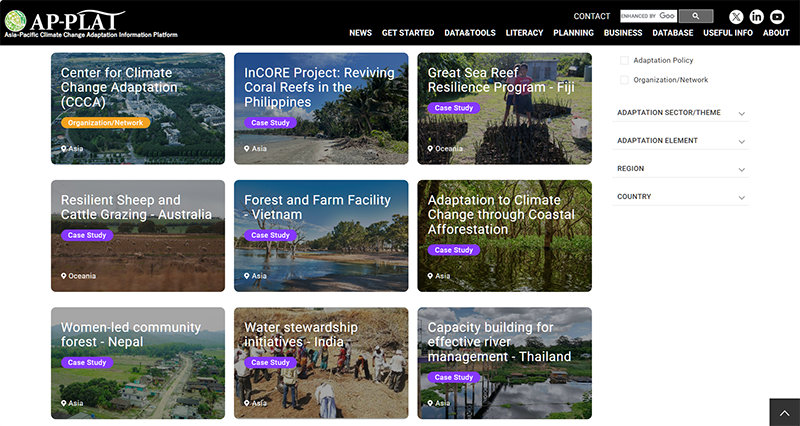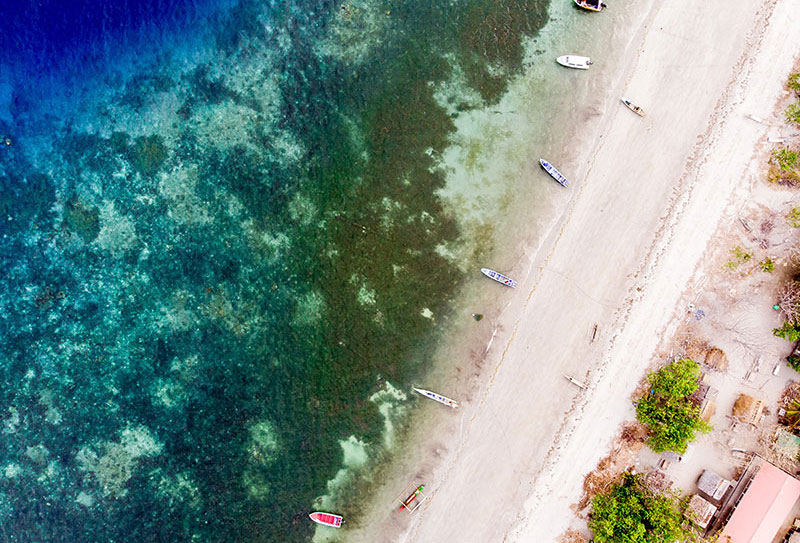As of October 2024, 143 developing countries were engaged in the formulation and implementation of their National Adaptation Plans (NAPs). Among them, 58 developing countries—including 22 Least Developed Countries (LDCs) and 13 Small Island Developing States (SIDS)—had submitted their NAPs to the UNFCCC secretariat. Of these 58 countries, 16 were from the Asia-Pacific region.

Understanding how neighboring countries or those facing similar climate risks are developing their National Adaptation Plans (NAPs) can be a valuable guide for your own efforts. This section offers an overview of NAP formulation, implementation, and revision, with a focus on the Asia-Pacific region.
Adaptation Database

Explore a comprehensive database with case studies from around the world, profiles of organizations working on climate adaptation, and policy insights, with a focus on the Asia-Pacific region.
Characteristics of the adaptation plans in the Asia-Pacific
This table provides a snapshot of the status of National Adaptation Plans (NAPs) and related documents across 39 countries in the Asia-Pacific region. Of these, 16 countries have submitted their NAPs to the UNFCCC. All 39 have submitted both National Communications (NCs) and Nationally Determined Contributions (NDCs).
You can access adaptation planning documents for each country directly from the table below.
- Acronyms
- NC – National Communication
- NDC – Nationally Determined Contribution
- NAPA – National Adaptation Programme of Action
- NAP – National Adaptation Plan
- AdCom – Adaptation Communication
| Sub-region | Country | Submission to the UNFCCC | ||||||||||
|---|---|---|---|---|---|---|---|---|---|---|---|---|
| NC | NDC | NAPA | NAP | AdCom | ||||||||
| Year | Version | Year | Version | Year | Version | Year | Version | Year | Version | |||
| East Asia | China | 2023 | 4 | 2021 | 2 | 2021 | 1 | |||||
| Japan | 2022 | 8 | 2021 | 4 | 2023 | 2 | ||||||
| Mongolia | 2024 | 4 | 2020 | 2 | ||||||||
| North Korea | 2013 | 2 | 2019 | 2 | ||||||||
| South Korea | 2019 | 4 | 2021 | 3 | 2023 | 1 | ||||||
| South East Asia | Brunei | 2017 | 2 | 2020 | 1 | |||||||
| Cambodia | 2022 | 3 | 2020 | 2 | 2007 | 1 | 2021 | 1 | ||||
| Indonesia | 2018 | 3 | 2021 | 2 | 2022 | 1 | ||||||
| Laos | 2024 | 3 | 2021 | 2 | 2009 | 1 | ||||||
| Malaysia | 2024 | 4 | 2021 | 2 | ||||||||
| Myanmar | 2012 | 1 | 2021 | 2 | 2013 | 1 | 2024 | 1 | ||||
| Philippines | 2014 | 2 | 2021 | 1 | 2024 | 1 | ||||||
| Singapore | 2018 | 4 | 2022 | 3 | 2022 | 1 | ||||||
| Thailand | 2022 | 4 | 2022 | 3 | 2024 | 1 | 2022 | 1 | ||||
| Timor Leste | 2020 | 2 | 2022 | 2 | 2011 | 1 | 2021 | 1 | 2021 | 1 | ||
| Vietnam | 2019 | 3 | 2022 | 3 | ||||||||
| South Asia | Bangladesh | 2018 | 3 | 2021 | 3 | 2005 | 1 | 2023 | 1 | |||
| Bhutan | 2021 | 3 | 2021 | 2 | 2006 | 1 | 2023 | 1 | 2023 | 1 | ||
| India | 2023 | 3 | 2022 | 2 | 2023 | 1 | ||||||
| Maldives | 2018 | 2 | 2020 | 2 | 2008 | 1 | ||||||
| Nepal | 2021 | 3 | 2020 | 2 | 2010 | 1 | 2021 | 1 | 2021 | 1 | ||
| Pakistan | 2019 | 2 | 2021 | 3 | 2023 | 1 | ||||||
| Sri Lanka | 2021 | 3 | 2021 | 3 | 2016 | 1 | ||||||
| Pacific | Australia | 2022 | 8 | 2022 | 4 | 2021 | 1 | |||||
| Cook Islands | 2020 | 3 | 2016 | 1 | ||||||||
| Fiji | 2020 | 3 | 2020 | 1 | 2018 | 1 | ||||||
| Kiribati | 2013 | 2 | 2016 | 1 | 2007 | 1 | 2020 | 2 | ||||
| Marshall Islands | 2015 | 2 | 2020 | 3 | 2023 | 1 | 2020 | 1 | ||||
| Micronesia | 2023 | 3 | 2016 | 1 | ||||||||
| Nauru | 2015 | 2 | 2021 | 1 | ||||||||
| New Zealand | 2022 | 8 | 2021 | 1 | 2022 | 2 | ||||||
| Niue | 2016 | 2 | 2016 | 1 | ||||||||
| Palau | 2019 | 2 | 2016 | 1 | ||||||||
| Papua New Guinea | 2015 | 2 | 2020 | 2 | 2023 | 1 | ||||||
| Samoa | 2010 | 2 | 2021 | 2 | 2005 | 2 | ||||||
| Solomon Islands | 2024 | 3 | 2021 | 1 | 2008 | 1 | ||||||
| Tonga | 2020 | 3 | 2020 | 1 | 2021 | 1 | ||||||
| Tuvalu | 2018 | 2 | 2016 | 1 | 2007 | 1 | ||||||
| Vanuatu | 2021 | 3 | 2022 | 3 | 2007 | 1 | ||||||
Interview

- ADAPTATION PLAN DEVELOPMENT PROCESS
- Whether you’re looking to update an adaptation plan or are intending to start on one, engaging in the adaptation planning process is important work. Once you identify where your country is located in the process, you will find useful information such as tools and good practices.

- NAP PROCESS UNDER THE UN FRAMEWORK
- Understand why adaptation planning is necessary in the long run to implement the Paris Agreement. Learn about the latest trends in international adaptation negotiations and support systems for NAP formulation under the UN bodies.

- Finance & Implementation
- Identify key points, good practices, and useful examples for financing both in the planning and implementation phases of adaptation.

- Monitoring & Evaluation
- Once adaptation measures are implemented, Monitoring and Evaluation (M&E) is conducted to track and evaluate the effectiveness of adaptation measures. Find useful resources including the latest discussions and good practices here.


